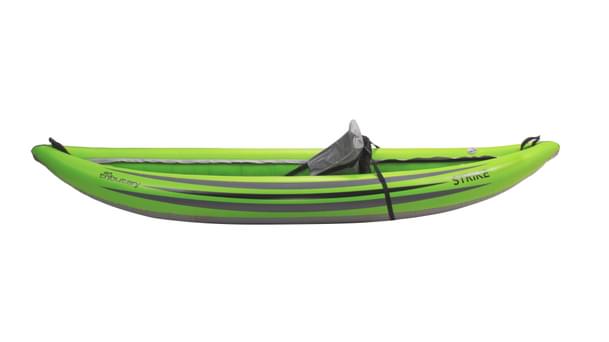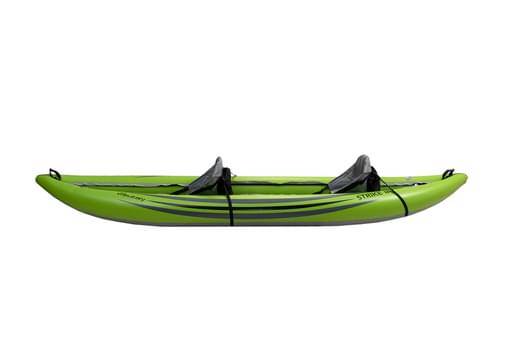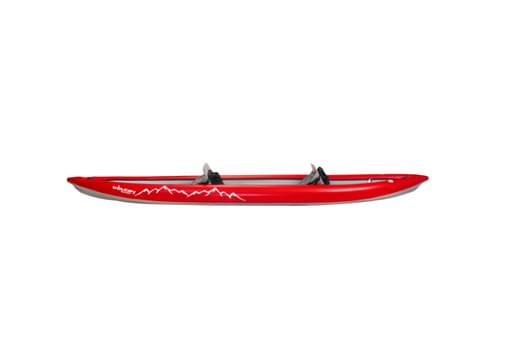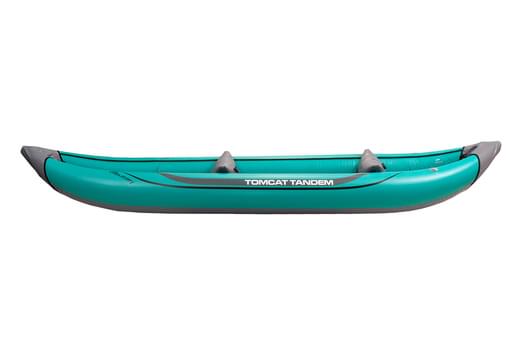- Home
- Gear & Reviews
- Bahiya
Bahiya
Bahiya Description
The Bahiya is a kayak brought to you by P&H Sea Kayaks. Read Bahiya reviews or submit your own review to share with the paddling community. Check out a few other kayak recommendations below or explore all kayaks to find the perfect one for you!
P&H Sea Kayaks
Bahiya Reviews
Read reviews for the Bahiya by P&H Sea Kayaks as submitted by your fellow paddlers. All of the reviews are created and written by paddlers like you, so be sure to submit your own review and be part of the community!
I bought a used Bahiya…
I bought a used Bahiya (pronounced BAH-i-YA) a few weeks ago. What an odd boat. I like it but is is markedly different than all the Romany/Explorer/Cetus/Force 4s out there which are predictable and stable. The Bahiya is predictable once you figure out what it likes and why. The deep V hull is a departure from the flat hulled boats I just mentioned and it has an interesting consequence; IF you paddle it expecting that it likes to stay flat and and level on the water (especially flat water) you will be rewarded with the deep V hull "searching" for stability which translates into twitchy. IF you keep your hips loose and alternate pressure on the foot pedals during the forward stroke the whole boats smooths out and feels lively and stable. If you stop and wait setting the hull to rest on the left or right side makes for a stable place to sit. It rewards a physical understanding of what is happening as you edge and move. I would not call this boat a good beginner boat. My favorite thing about it is how easy it is to edge steer it with hip tilt. Raising the inside edge of the boat onto the hard chine will result in a steady turn to that side. This enables the paddler to continue with a forward stroke steering at least partially with lower body. Not as easy or efficient as a rudder but useful and effective in the right hands. The boat is surprisingly skeg dependent in beam or quartering wind ... not impossible with the skeg up but it weathercocks more than you might expect for a Greenland style, hard chine boat. That is all for now. : )
Good speed and fair…
The Bahiya: as good as a hard…
I first demo’ed the Bahiya as…
It was love at first outing, and I went home with one of the 12 prototypes. I have paddled it ever since 1997. P&H where originally going to abandon Project X in favour of Y (latterly known as the Capella), believing X (the Bahiya) had a limited market. I was one of those who persuaded P&H to rethink and market.
The Bahiya has a fast effortless cruise that will see off most contemporaries. However, unlike most fast kayaks, when edged over hard, it will out turn just about any kayak of its length, simply by lifting one’s knee. No other sea kayak has this compromise of speed and agility. The slight compromise is that when sitting still, it does twitch slightly, but not enough to stop me taking photos and fishing from it. Once moving, the Bahiya is playful and rewards with confident feedback so that the kayak can be leaned into a turn until water is beyond the deck lines and cockpit coaming.
The Bahiya turns best in flat conditions at an all up weight of 105kg. As weight is added, it becomes more stable and directional to 200kg. In a following sea, it is truly awesome, and will pick-up the wave and be gone leaving many so called fast kayaks standing. The ability to edge turn allows the swell to be acquired, a direction set and to speed across the wave on the chine.
This agility and speed makes the Bahiya perfect for trip leading, allowing one the ability to nip around the group for communication and improves safety by allowing one to turn quickly and get to the incident. I rarely use the skeg, but it is easy to use and effective in heavy quartering seas. I have used the Bahiya on lightly loaded evening paddles to multi-day expeditions. I found the 3 compartments with large dry hatches perfect for allowing quick packing and unpacking. I put tent inner and fly sheet either side of the skeg box and can use the whole kayak. The deep V allows for easy packing at the front.
The lack of upturned ends reduces weather-cocking. The upside down tear drop cross-section of the bow is perfect as it slices smoothly through small waves, but rides dry over larger waves.
After 13 years paddling, my only two very minor issues are a) seat replaced as the mount point broke after a lot of hard turns. I replaced the coaming for £200, b) Steep V bow takes some wear at the foot, easily remedied by a sacrificial keel strip.
My trademark move made possible by this kayak is to turn 180 degrees in a J turn from full reverse to going forward, by use of a single sculling sweep with the kayak put right over on its side with the body on the waters surface. This is only possible via the tremendous secondary stability that the Bahiya offers.
Yes, I thoroughly recommend this kayak, and too many of my friends regret ever selling theirs on for a newer model.
After much reading and…
Construction, fiberglass is excellent. Slightly lighter than Valley or Nigel Foster boats - the light weight facilitates lifting and an easy shoulder carry. Bolts are glassed over or capped. Hatch covers are Kajak, last much longer than Valley's. The skeg deploys and retracts easily. The cockpit is comfortable, some personal padding has been installed.
The cockpit rim allows spray skirt attachment with ease. I had been warned about excessive tippiness by several owners and dealers. Slightly more so than my Legend, but no problem. Light initially, firms up with leaning. Tracking is quite straight with the barest trace of weathercocking. A light edging or using the skeg remedies that. In 2-3 foot chop no spray makes it to the cockpit.
The boat: rolls easily, catches waves quickly, and holds good speed with little exertion. The hatches do not leak. Although I do not consider the Bahiya too tippy, it is not a beginner's kayak.
I am happy with my choice
I am 5'11" 220lbs with a shoe…
As other reviewers have said, the boat gets up to speed very quickly. Very fast. With a committed edge you can make the boat turn easily for you. Rolls rather easily. Beautiful looking boat. Didn't play with the skeg at all. Plenty of room fore and aft for gear and possibly a 10 day trip.
Will demo the Tiderace Xplore-S before I pull the trigger on the Bahiya.
I've had my Bahiya for only a…
I would rate my paddling skills as intermediate but focus a lot on greenland rolling which I would consider myself advanced at, so some of my critiques stem from the lack of a traditional ocean cockpit and smallish thigh braces... at least for my size 6ft 195lbs.
The boat is quite fast and for me comes up to speed rather quickly even in 2-3 ft confused seas. I would rate the initial stability as somewhat low in flat water but that being said, it firms up nicely in rough conditions and can be edged til the cockpit coming is in the water without bucking me.
On flat water it seems to turn very quickly when placed on edge but in rougher conditions the high volume bow seems to get pinned and pushed around when I try and bring the boat around. I think for that reason it may be bit hard to maneuver quickly inside breaking waves especially when they are breaking close together. It also has tendency to broach quickly in a following sea but this is controllable with bow rudders and a little skeg if need be. There are better surfing boats out there for sure.
Gear capacity is good. Should have no problem on trips up to two weeks. Hatches are water tight and the seating system is uber comfortable. It rolls well but is not really a boat for all the fancy greenland rolls. I feel like there is not enough bite to the thigh braces. I have meaty legs though. Construction is great but I have one gelcoat blem near the stern. Looks like an air pocket. It will crack and peel but its an easy fix.
All in all a fast and fun but challenging boat. It will make you a better paddler.
This boat excels in a lot of…
The manufacturer's site says it's not a boat for beginners, and I'd have to agree. The narrow width, hard chine and deep V hull shape result in low initial stability. That having been said, I'm not a big guy (5' 10", 155 lbs, 30" inseam, size 11 feet) and I think this boat would settle down with a somewhat heavier paddler. A (heavier) friend of mine, who ordinarily paddles a very stable Tsunami, had no problems with the stability of this boat. It wouldn't be my first choice as a platform for nature photography, but it's stable enough on center. The hard chines also mean rock solid secondary stability - you can put it on edge then stay there all day.
It is not a boat for the truly tall or stocky. Another big guy from among my friends wanted to try this boat but couldn't get his legs under the thigh braces (admittedly, he was bundled up in a dry suit plus several layers when he tried).
I have found that it takes only gentle edging to turn - no worse than other boats of its length.
The quality of the manufacturing is quite high - I haven't found any blemishes or problems with mine.
I'm 5'6", 160 lbs, 30"inseam,…
Paddling the Bahiya-The initial stability is actually quite good for a 20.5” beam and firms up more in wave action. The hard chines allow you (rather require you) to edge the kayak to execute turns. Once on edge it feels rock solid. I can sit comfortably on edge. It is extremely fast. At a touring pace I passed small sail boaters on Kent Lake. It tracks very well in calm water. In heavier wave action tracking was affected slightly. I did not have to use many correction strokes only a lift of a knee and I was back on course. I am 160 lbs. right at the minimum recommended weight for this boat. I did notice that the wind mildly affected the tracking as well. This was the result of a little too much freeboard when boat was empty. I loaded approx 25 additional lbs into the hatches and the handling and tracking improved greatly. The only time I even thought about using the skeg was in quartering waves from larger boat wakes but never had to deploy it. I suspect that in constant quartering seas I would need the skeg at least partially deployed.
The weight is around 60 lbs which is manageable both on and off the water. The deck height is around 13” but actually feels lower due to the deep V hull design. The back deck is fairly high making it difficult to lay back on. The workmanship and quality are second to none. The boat is a 2003 model. It has a hung fiberglass seat that is narrower than the newer models and fits me wonderfully. The front bulkhead is foamed out (no foot rests) so it is very comfortable on the feet.
Overall I would have to say that the Bahiya is a very high quality and capable Sea Kayak. As stated by other reviewers it requires edging to turn sharply. I have a low center of gravity so it did not feel that "tippy" to me. I only rated it 9 out of ten because of the need to load the boat to reach the optimum waterline. This kayak is not strictly for "experienced" paddlers but it does require some level of comfort edging and bracing.
Reading the last review, I…
I don't own a Bahiya, but I've demoed one several times and I've found I have no trouble edging the boat and carving turns....Back paddling to assist in turning as mentioned by the previous poster? I don't think so. YOU HAVE TO EDGE THE KAYAK! The boats initial stability is fairly solid, however, with some inexperienced paddlers, it may feel a little "playful." I can't comment on secondary stability due to the paddling conditions.
Rolling the boat was smooth and required very little driving of the knee to bring it upright.
I would probably consider owning this boat, but I wasn't as comfortable in the cockpit as other boats I've demoed and now own.
I don't mean to get into a debate about the Bahiya, but based on the info by the previous poster and the fact they're a beginner (in a more advanced design), and a rating of 5 out of 10, Come on!
My rating is probably unfair…
We tested the Bahiya in…
With the introduction of the Bahiya, P&H seems to have aimed at the introduction of a fast seakayak with a real Eskimo-appearance. In our opinion they succeeded very well in this, because the Bahiya is much alike the AnasAcuta; the kayak with the most beautiful lines. What really catches the eye is the bow of the Bahiya because it is as sharp as a knive. However this is combined with much flair to prevent the bow from diving in waves. However, in spite of this, we suspect the Bahiya in big surf to dive deep and causing a salto. We found it a pity that de surf we met during our test, was unsufficient to check this. May be that other testers can take a look at that issue.
Regarding the cargoroom, the Bahiya has more possibilities then the AnasAcuta, because with a volume of 305 litres there is enough room in the Bahiya to pack a complete camping-gear. Only for long expeditions you may need more volume. For day - and weekend trips the volume is more than sufficient.
The Bahiya is certainly a very fast seakayak. It is like a runninghorse and not particularly suited for beginners. We think like this because of the stability in combination with the need to edge beyond the capsizing point while manouverating it. The primary stability is reasonably good on flat water. The secundairy stability comes in really fast at a few angles of heel. When you edge further you get the feeling you will capsize because the secundairy stability is low and the only way to stay uprigth is to use your paddle. Of course this is no problem at all on flat water.
On flat water you have no stability-problems and you can easily turn the Bahiya by edging far beyond the capsizing point while making sweeps. The Bahiya turns out to be quite maneuverable then. However, if you want to do this at sea in waves it is a complete different story while you can definitly do this, when your paddling technique is OK, but you have certainly much less safety-margin. Of course this is also, partially a matter of getting used to the kayak, but we found that the Bahiya was difficult to turn in bigger waves and in surf. The reason for this is that we edged not as far as we were able to on flat water.
Looking at the behaviour in wind we found out that the Bahiya only weathercocks very little in 6 Beaufort, which could easily be adjusted with the retractable skeg. Dropping the skeg totaly made the Bahiya leecocking. So we think this combination gives a well balanced kayak that can be trimmed properly.
There is one thing we found less comfortable. While paddling with waves and wind from rigth or left it is difficult to turn downwind. We first faced this in 4 Beaufort and could then easily solve this by dropping the retractable skeg, because of which the Bahiya leecocks and that was what we aimed at because we wanted to turn downwind. Trying the same in waves and in 6 Beaufort this didn't work out the same. Of course, dropping the skeg helped a bit but still you have to work hard to turn the Bahiya while making big sweeps and edging quit a lot. With the waves coming from the side we think this is not something a beginner is able to.
The Bahiya is not really a kayak to play in surf. Of course it is possible to play in surf and you can have fun with it while reaching a high speed while surfing. But you don't have much safetymargin with regard to stability. As mentioned above we suspect the Bahiya to be able to dive deep with a following surf.
Kayaking in a following sea is a pleasure for one thing because it surfes really, really fast. I am still getting enthousiastic when I think of the speed I reached. On the other hand when you are just paddling and don't want to surf in a sea like this, you must stay very alert while paddling to prevent broaching all the time. Dropping the retractable skeg fully, helps only a little bit and we think the Bahiya really needs a bigger skeg for this conditions.
Kayaking the Bahiya is something you must dare to do. This means that you, for steering the Bahiya, must shift your weigth under simultanesly edging and making sweeps. When you are up to that, the Bahiya is a joy to paddle because it is fast and runs, no it is dancing, ligthly over the waves.
Kayaking the Bihiya in the conditions we tested it, required that we had a perfect fit in it. The standard seat and knee rests prooved to be unsufficient in this. When bending backwards the hips lift a litle bit and the fit becomes too loose because the sides of the seat becomes wider when going upwards. With fitting quite a lot of foam blocks in the hip area and for the kneegrip we improved the fit and could handle the Bahiya very well. Without this perfect fit we felt quit uncertain in it. Of course everybody is free to adjust the seat to personal needs and we advise urgently to do this at the bahiya and to reach a secure lock in the seat, especially when you are not very heavily build.
We don't like the backrest either, but because of the fact that it is quit easily to change it to personals needs, it is not a serious issue for judging the bahiya at.
However a serious point is the tigthness of the hatches. We kept the Bahiya edged 90° in waves and found that water had entered in all three compartments: 10 liter water all together. We think it must be the hatches because the water came in all compartments and it should be too much coincidence if there were three leaks at another place. The Dutch Kayakstore Tiekano couldn't believe it because these hatches are in use for some years without complaints, they say. They promised to test it at the same kayak to reproduce the problem and to find out what had happened there. Until now they didn't report it back to us. In my opinion it could be that the tension between hatches and rim was a little low. Another cause could be the fact that we, before taking off in the waves, bended the edges of the hatch under the rim, just like you have to do at the oval hatches from Valley. We think it should be fine to find out the cause of the leakage, just to know wether it is a failure or that the hatches must be treated in a special way.
What we think the position of the spare paddles on the back-deck to be a bit strange. The hatch is that big that there is no place left for suficient bungee cords. Therefore one spare-paddle covers the day-hatch completely. When you bring that sparepaddle-part to the foredeck you have a simular problem because the blade covers quit a lot of your map-area. Probably this can be solved by asking other positions of the bungee cords on the foredeck.
Looking at the quality we found some places of unsufficient impregnation. Especially the internal connection between deck and hull. Because this kayak was only the 15th from the mould, it was probably build in a hurry for the introduction. But be aware of these kind of things.
Because the Bahiya is, in a certain way, family of the AnasAcuta, I will mention a few words about comparing both kayaks. The paddling - and edging behaviour of the Bahiya is very much the same as the AnasAcuta, which, for example has the same broaching characteristics in a following sea as the Bahiya shows.
Still there is an important difference between both kayaks because the AnasAcuta is not fast at all especially when there are no waves. On the other hand the AnasAcuta has a very high primary stability: "like a rock"! With that you have a better platform in the AnasAcuta then with the Bahiya, especially in situations in which you must edge beyond the capsizing point and have to stay uprigth with your paddling technique. Because of this the Bahiya is not such a "heavy sea"-kajak as the AnasAcuta is, but with the Bahiya you can still, as it has been proved by us in the test, also face heavy seaconditions.
Summarizing, we think the Bahiya is dream to paddle for the experienced paddler who, however, has less safetymargins in it; migth it happen that he runs into trouble. We have no severe criticism on the Bahiya as a kayak. However we think it is essential the hatches must be watertigth.
Furthermore we are used to perfect quality of P&H-products and we think that the quality inspector must, in the future, pay more attention to the impregnation of the inside seam between deck and body, to the finishing of the glass from of the inside seam between deck and body in front and back and to the assembling of the seat that has now been assembled not symetrically,
Finally some suggestions for improvement of the Bahiya:
- A larger retractable skeg for quieter running in a following sea.
- We also want to plead for a small- or oceancockpit to become available as extra option, just to reach a very secure fit in de seat. Or, if P&H thinks the investment to be too high for that, it should be a perfect idea as well if a special part could be developed; a part you can screw into the cockpit to make the opening smaller and giving better knee-contact. This can be usefull for all the kayakers who like a small cockpit.
The above is a summary of the review we wrote in Dutch. The review can be found at http://dezeekajaksite.tiscaliweb.nl. Probably you can't read Dutch, but there are quit a lot of photographs of the Bahiya to be found as well.
I was attracted to the…
The seat is adjustable forward or aft in one of two positions, and has a very comfortable adjustable Explorer back band, which is able to pivot easily forward and aft. The cockpit is of moderate size and my scrawny 5’7”, 135-pound frame fits just fine, obviously. The space between the seat and hull is only about 4 cm wide, and this is too narrow to store anything other than a tightly rolled paddle float. The boat has a full complement of deck lines, extensive bungies on the foredeck, and a couple of bungies on the rear deck designed to carry a spare paddle. The fittings are all recessed, but are glassed over on the inside to preclude the hardware snagging your gear or clothing.
At 52 cm (about 20.4 inches) wide, the boat is expectedly a little less stable than many other sea kayaks, and probably not a good first kayak for that reason. In heavy winds, the boat tends to weathercock slightly but not at all uncontrollably. With the skeg deployed, it turns to the downwind direction, but not fully. I always require a lean and a few sweep strokes to turn it fully downwind. When surfing or in quartering seas, it seems to have a slightly greater tendency to yaw or broach than my Valley Nordkapp. I have not yet paddled it fully loaded, but expect the boat to become considerably more stable in that condition. The boat is extremely easy (and fun) to edge and turn. Being narrow as it is, and with comfortable bracing for the knees, it is an easy boat to roll. This easy handling is certainly the most pleasing feature of the boat.
All in all, this is an impressive boat that fills a niche for a high-performing sea kayak that is fast and nimble, but has the comfort and capacity for moderate-length trips.
